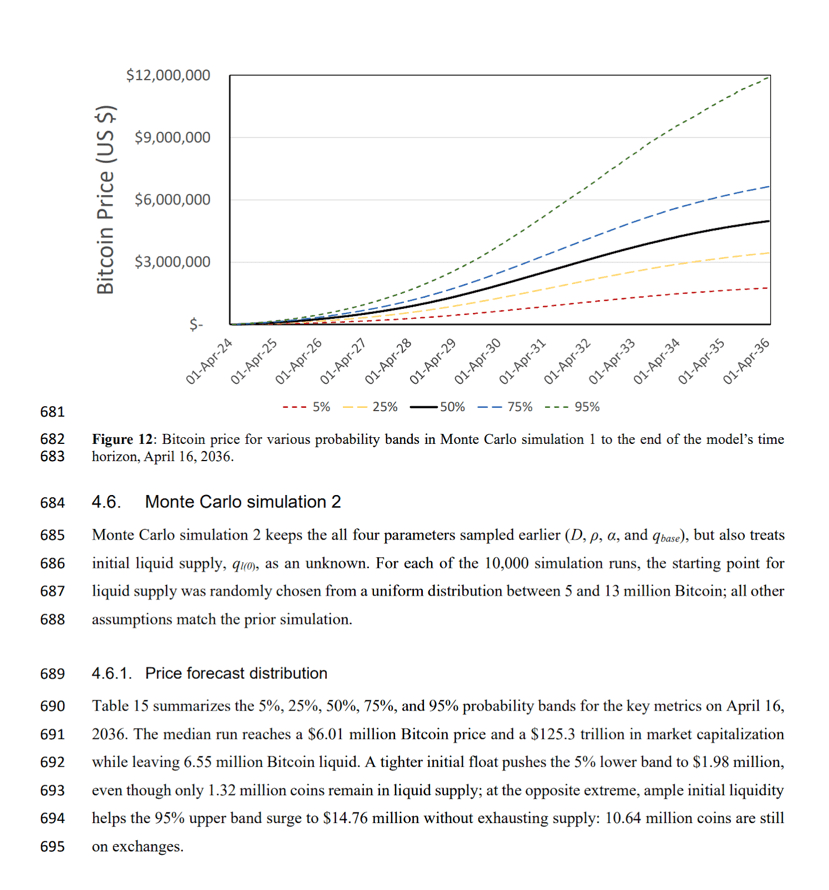A new study by Satoshi Action Education indicates a 75% chance that the price of Bitcoin will exceed $4.81 million by April 2036.
The study, led by economist Murray A. Rudd, uses an updated probability model to examine how institutional supply and demand constraints affect long-term valuations.
Supply and price shock scenarios in Bitcoin
Updated results show a superior price of 75% at $4.81 million by April 2036. The superior performance range of 25% reaches $10.22 million, while the upper limit of 95% ranges from $11.9 million to $14.76 million, depending on the simulation parameters.
In the most extreme simulations, representing 1%, the price peak approaches $50 million. The median expectations range between approximately $6.55 million and $6.96 million for the same date. The supply cap of 21 million bitcoins, along with expected cash liquidity estimated at around 3 million bitcoins, forms the basis of the supply.
Long-term storage, corporate guarantees, decentralized finance (DeFi) activity, and layer two networks are expected to lead to further decreases in the tradable supply. The baseline and mid-scenarios maintain the liquid supply between 6.55 million and 6.96 million bitcoins by April 2036, alleviating extreme expectations.

Pathway simulations illustrate how continuous withdrawals from trading platforms can accelerate the occurrence of liquidity shortages. If the circulating liquidity supply drops below 2 million bitcoins with reduced deflation sensitivity, the model shows that prices could rise rapidly.
In the worst-case scenarios, liquid supply drops below 2 million bitcoins by January 19, 2026, and below 1 million bitcoins by December 7, 2027.
Portfolio strategy implications
The model also incorporates patterns of institutional accumulation, leading to slowed purchases during rising periods and increased buying during stable conditions.
Furthermore, the study indicates that investor awareness of liquidity risks will be essential as reliance on it grows. The study emphasizes the narrow margin between sustainable scarcity and destabilizing depletion, with the latter likely to cause disproportionate volatility.
These results have implications for portfolio strategy and policies. For long-term investors, the sharp right tail of the price distribution supports strategies that account for asymmetric upside probabilities while considering liquidity constraints.
Policymakers may need to address custody concentration and cross-border capital flows, with increasing pressures on the circulating supply due to corporate treasury bonds, sovereign reserves, and token initiatives.
By combining macro-level adoption curves and micro-level liquidity events, the Monte Carlo framework and Epstein-Zin specifications provide a more comprehensive view than simpler forecasting models.
Multiple constraints were integrated to simulate how the price of Bitcoin evolves under different market and policy conditions.
On Thursday, surpassing $124,000, reaching its all-time high. The price increased by nearly 8% over the past week. Analysts point to a confluence of bullish on-chain signals, suggesting that this rally may still have room to continue.
Follow me now for daily, comprehensive updates on Bitcoin, Ethereum, and other currencies.
@Caldera Official #caldera @BounceBit bit#BounceBitPrime، @Treehouse Official #Treehouse @undefined #elaouzi
#builtonsolayer @Solayer _labs
